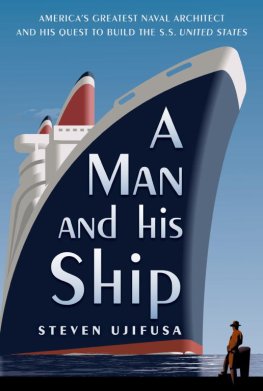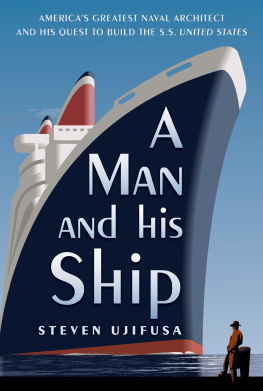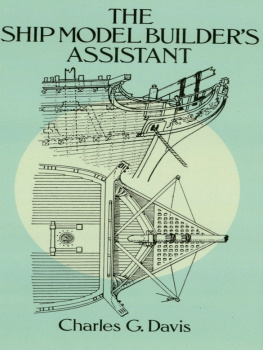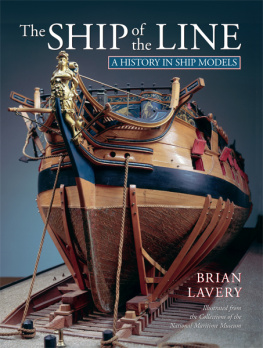Steven Ujifusa
A MAN AND HIS SHIP
AMERICAS GREATEST NAVAL ARCHITECT AND HIS QUEST TO BUILD THE S.S. UNITED STATES
To my grandmother Judith Follmann,
world traveler, woman of culture,
and the inspiration for this book


 The United States LinesProposed Transatlantic Liner
The United States LinesProposed Transatlantic Liner-S.S. UNITED STATES-
Length o.a. 990 ft Beam 101.5 ftDraft 37.5 ft Gross Tons 53,329Steam Turbine Powered, Quadruple ScrewEstimated Speed: 35 knotsAccom: 2000 Passengers, 1000 CrewNewport News Shipbuilding & Drydock Company06/15/1950
The transatlantic ocean liner possessed a mystique now lost to the world. For the first half of the twentieth century, ships named Mauretania, Bremen, Normandie, and Queen Mary were known and loved by tens of millions of people on both sides of the Atlantic. When a big liner arrived in New York City for the first time, thousands lined the Hudson to watch a man-made objectone that seemed to have life and soulmove serenely upriver. Their eyes were following something simply massiveshe could be up to five city blocks long and twelve stories high, her deep-throated whistles bellowing in response to a cheering crowd. Sculpted hull, gleaming paint, and raked-back smokestacks conveyed beauty, power, and speed.
In the New York newspapers, the shipping news doubled as society news, as readers learned if Greta Garbo, Cary Grant, Margaret Truman, Vincent and Brooke Astor, or the Duke and Duchess of Windsor were aboard one of the ocean liners arriving or leaving that day. When a great ship left for Europe, it was an occasion awash in champagne and laughter. On board, first-class passengers enjoyed public rooms and private quarters that were decorative showplaces for the worlds most talented designers, men and women who created some of the most stunning interiors ever built on land or sea. En route, high standards of service for the ships most privileged passengers meant money for its owners and prestige for the nation whose flag she flew. Ships connected businessmen to transatlantic partners, diplomats to their posts, jazz artists to European audiences, students to adventures, immigrants to American jobs, and refugees to freedom. During two devastating world wars, liners converted to troopships carried millions of GIs to the front, and then brought them home again in triumph.
To the public, the ocean lineronce the only way to get across the Atlanticwas the epitome of glamorous travel. She also represented the pinnacle of technologythe most complex and powerful machine on earth. Deep inside her hull were engines capable of propelling a thousand-foot-long mass of steel through the giant waves of the North Atlantic at nearly 40 miles per hour. The liner that crossed the Atlantic the fastest captured a prize called the Blue Riband. A winner became the most famous ship in the worlduntil a faster rival bested her.
From the 1860s to the 1950s, all of the liners that captured the Blue Riband flew European flags, as a passive America seemed to accept the superiority of foreign engineering, manufacturing, and managerial prowess. One American did not, and this is the story of his quest to build the fastest, most beautiful, and safest ocean liner everthe ship that was to become one of the greatest engineering triumphs in American history.
BOOK I
THE MAN AND THE VISION

1. SIZE, LUXURY, AND SPEED
The first time he saw an ocean liner, little Willy Gibbs knew what he wanted to do with his life.
On a rainy November 13, 1894, twenty-five thousand people waited outside the gates of Philadelphias Cramp Shipyard on the banks of the Delaware River. They were there to see a marvel of the age: the steamship St. Louis, one of the largest ocean liners in the world and Americas brand-new entry into the transatlantic passenger trade. When the gates opened, people surged toward the ship. She was 550 feet long and decorated from stem to stern with flags of the world, with the American Stars and Stripes flying high above the bow.
The owner of the new ship, Philadelphia businessman Clement Griscom, was on his way to the shipyard with the christening party, headed by the bulky U.S. president, Grover Cleveland and the elegant, much younger first lady, Frances Cleveland. A chuffing Pennsylvania Railroad locomotive pulled the presidential train right up to the Cramp Shipyard gates. Stepping out, the first lady took Griscoms arm, and the group of dignitaries walked to the launching platform, joined along the way by shipyard owner Charles H. Cramp.
Among those watching the scene was the forty-eight-year-old William Warren Gibbs, a crafty, aggressive financier who was said to sit on more boards of directors than any other man in America. On this blustery fall day, he had brought his two young sonseight-year-old William Francis and six-year-old Fredericto watch the launch of the great liner.
Self-made William Warren Gibbs was one of Philadelphias most daring entrepreneurs. His physical appearance matched his temperament: he was lean, with fierce, defiant eyes, and a dark, pointed beard. A farm boy from the small town of Hope, New Jersey, he had arrived in the city thirty years before with little more than a skill for persuasion, but went on to become a multimillionaire laying gas lines and selling electric batteries. The United Gas Improvement and Electric Storage Battery companies had also enriched many of the citys leading citizens. When he brought his sons to see the launch of St. Louis, he was rumored to be worth $15 million, a stupendous pile of money in 1894.1 His sometime partner in the gas business was a well-connected member of an old Philadelphia family: St. Louiss owner Clement Griscom, president of the International Navigation Company, a shipping firm he founded with the help of the mighty Pennsylvania Railroad.
William Warren Gibbs might have looked at ships with an eye for profit. But for his eight-year-old son William Francis, seeing a great ship was pure poetry. During summer days at the familys summer home on the New Jersey shore, the boy scanned the horizon for funnels, masts, and black smudges of coal smoke, and then sketched what he saw. He knew that as he looked north, ocean liners, growing bigger and faster every year, were sailing in and out of the great port city of New York. Little Willy yearned for a closer look at one of these ocean greyhounds.
And now, at his fathers side, he had his chanceSt. Louis was a liner of vigorous beauty, her graceful hull draped with red, white, and blue bunting.
The shipyard was also a marvel to behold. William Cramp & Sons had been building cargo ships, passenger liners, and warships for over sixty years. The proud standard bearer for Philadelphias industrial might, Cramps employed more than five thousand workers, many of them immigrants from Ireland and Italy.2 In the yard was a towering crane, perched atop a floating barge, that could pick up a seventy-ton boiler and deftly swing it into the hull of a ship over three hundred feet away. Muscular riveters put hulls together by hammering red-hot rivets into steel and iron plates. Roaring orange fires glowed from forges where men shaped mammoth pistons, propellers, and funnels with the precision of watchmakers.















 The United States LinesProposed Transatlantic Liner-S.S. UNITED STATES-Length o.a. 990 ft Beam 101.5 ftDraft 37.5 ft Gross Tons 53,329Steam Turbine Powered, Quadruple ScrewEstimated Speed: 35 knotsAccom: 2000 Passengers, 1000 CrewNewport News Shipbuilding & Drydock Company06/15/1950
The United States LinesProposed Transatlantic Liner-S.S. UNITED STATES-Length o.a. 990 ft Beam 101.5 ftDraft 37.5 ft Gross Tons 53,329Steam Turbine Powered, Quadruple ScrewEstimated Speed: 35 knotsAccom: 2000 Passengers, 1000 CrewNewport News Shipbuilding & Drydock Company06/15/1950 